ACC 707: Auditing and Assurance Services - Assertion Risks Analysis
VerifiedAdded on 2023/04/22
|16
|3847
|409
Report
AI Summary
This report evaluates two case studies to identify assertion risks and apply substantive audit procedures. In the case of Advanced Computer Solutions, the auditor identifies completeness and accuracy as key assertions at risk due to potential inventory misstatements and inaccurate valuation. Substantive audit procedures, including scrutiny of physical inventory counts and reconciliation of inventory values, are recommended. The report also highlights the importance of ASA 701 in communicating key audit matters to stakeholders. For Green Machine Limited, accuracy and valuation are identified as key assertions at risk related to property, plant, and equipment (PPE) due to improper capitalization of expenses and inaccurate depreciation rates. Recommended substantive audit procedures include reviewing expense capitalization procedures and verifying PPE valuation. The report emphasizes the auditor's responsibility in addressing these risks and ensuring transparent financial reporting.
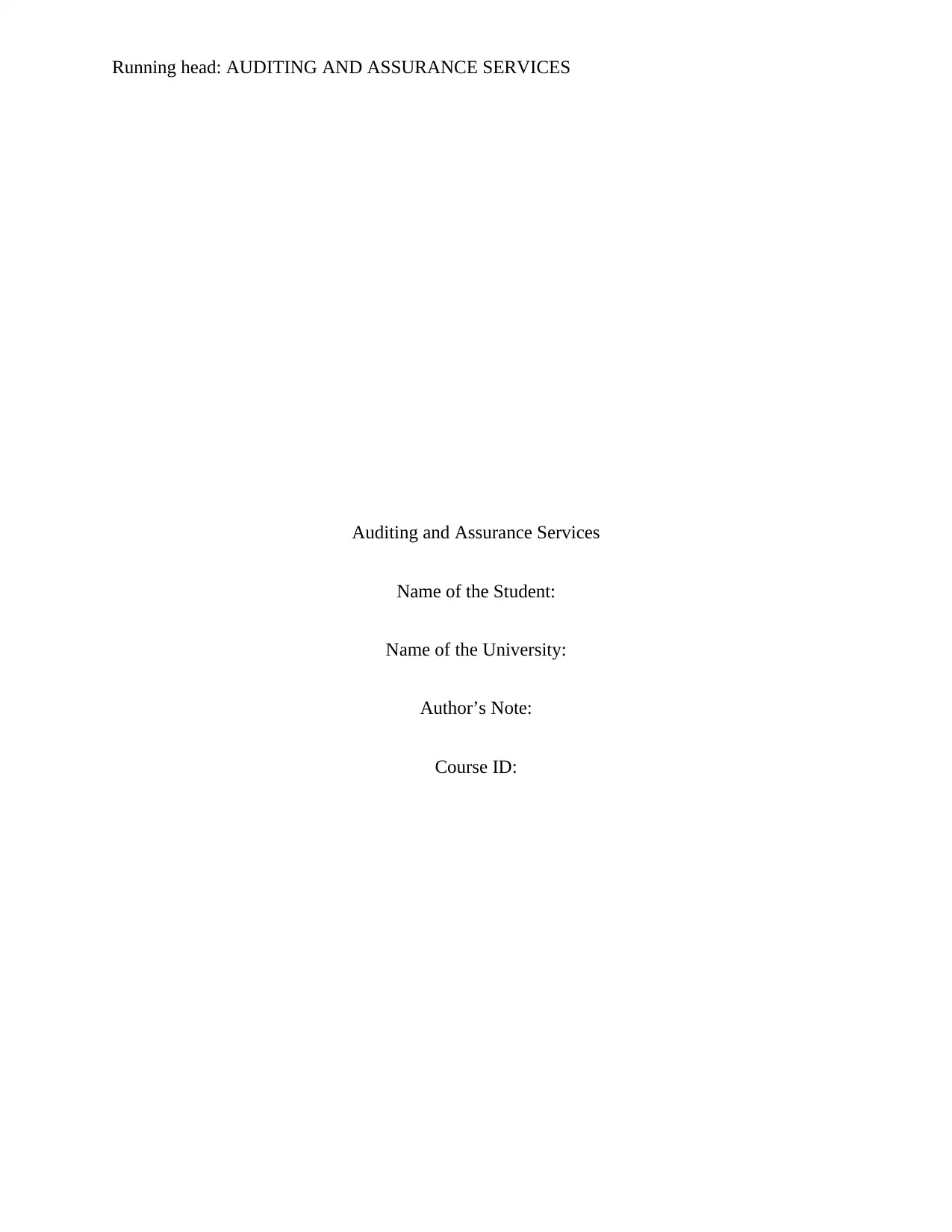
Running head: AUDITING AND ASSURANCE SERVICES
Auditing and Assurance Services
Name of the Student:
Name of the University:
Author’s Note:
Course ID:
Auditing and Assurance Services
Name of the Student:
Name of the University:
Author’s Note:
Course ID:
Paraphrase This Document
Need a fresh take? Get an instant paraphrase of this document with our AI Paraphraser
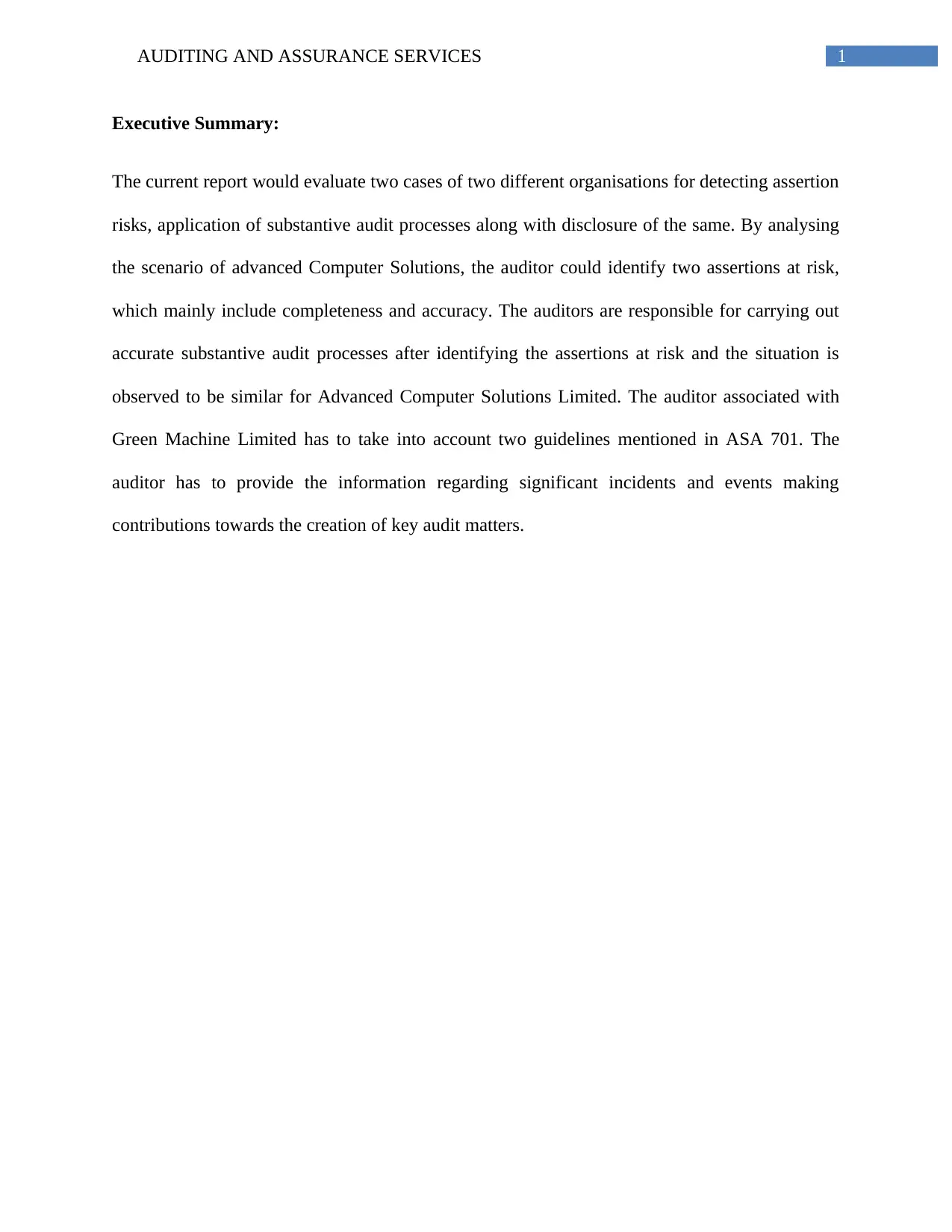
1AUDITING AND ASSURANCE SERVICES
Executive Summary:
The current report would evaluate two cases of two different organisations for detecting assertion
risks, application of substantive audit processes along with disclosure of the same. By analysing
the scenario of advanced Computer Solutions, the auditor could identify two assertions at risk,
which mainly include completeness and accuracy. The auditors are responsible for carrying out
accurate substantive audit processes after identifying the assertions at risk and the situation is
observed to be similar for Advanced Computer Solutions Limited. The auditor associated with
Green Machine Limited has to take into account two guidelines mentioned in ASA 701. The
auditor has to provide the information regarding significant incidents and events making
contributions towards the creation of key audit matters.
Executive Summary:
The current report would evaluate two cases of two different organisations for detecting assertion
risks, application of substantive audit processes along with disclosure of the same. By analysing
the scenario of advanced Computer Solutions, the auditor could identify two assertions at risk,
which mainly include completeness and accuracy. The auditors are responsible for carrying out
accurate substantive audit processes after identifying the assertions at risk and the situation is
observed to be similar for Advanced Computer Solutions Limited. The auditor associated with
Green Machine Limited has to take into account two guidelines mentioned in ASA 701. The
auditor has to provide the information regarding significant incidents and events making
contributions towards the creation of key audit matters.
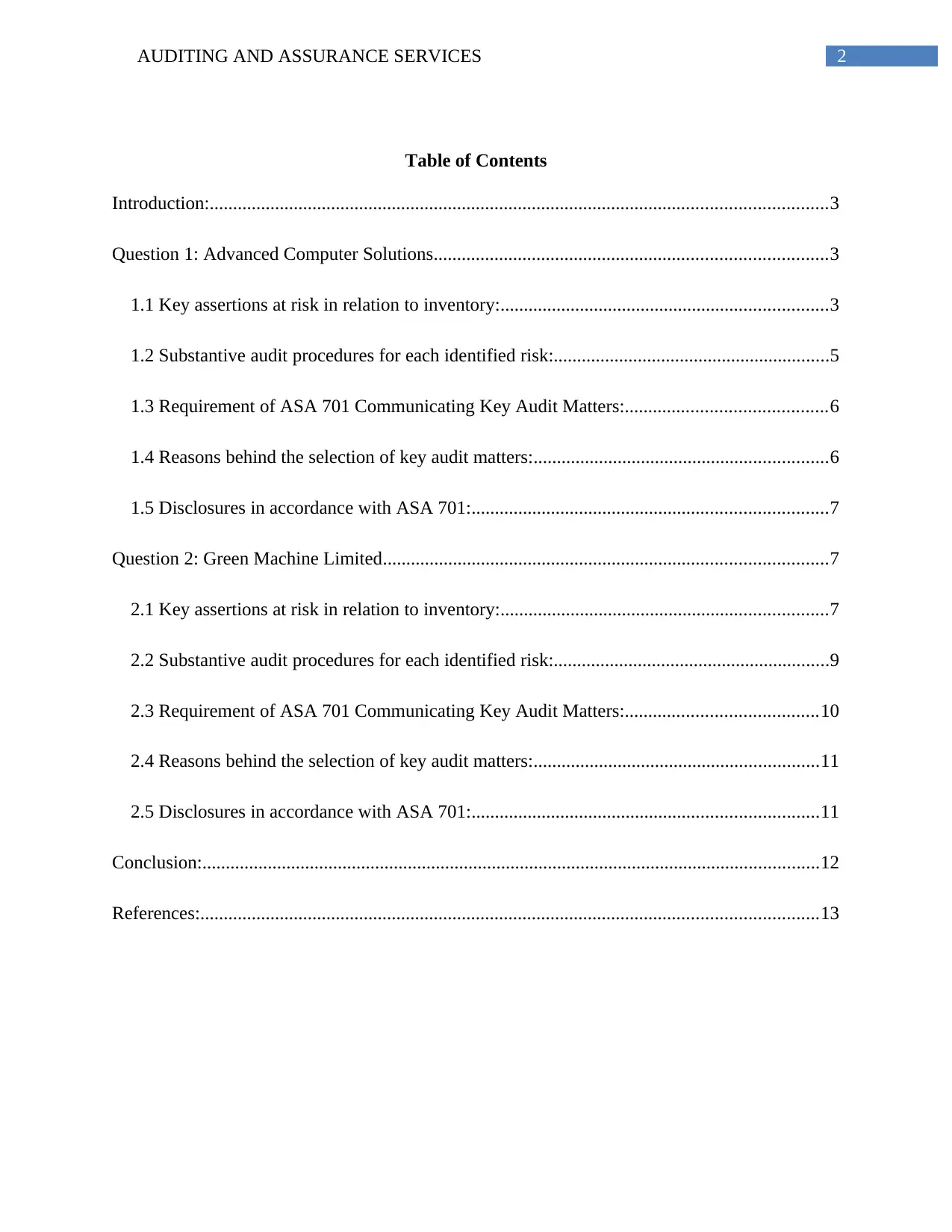
2AUDITING AND ASSURANCE SERVICES
Table of Contents
Introduction:....................................................................................................................................3
Question 1: Advanced Computer Solutions....................................................................................3
1.1 Key assertions at risk in relation to inventory:......................................................................3
1.2 Substantive audit procedures for each identified risk:...........................................................5
1.3 Requirement of ASA 701 Communicating Key Audit Matters:...........................................6
1.4 Reasons behind the selection of key audit matters:...............................................................6
1.5 Disclosures in accordance with ASA 701:............................................................................7
Question 2: Green Machine Limited...............................................................................................7
2.1 Key assertions at risk in relation to inventory:......................................................................7
2.2 Substantive audit procedures for each identified risk:...........................................................9
2.3 Requirement of ASA 701 Communicating Key Audit Matters:.........................................10
2.4 Reasons behind the selection of key audit matters:.............................................................11
2.5 Disclosures in accordance with ASA 701:..........................................................................11
Conclusion:....................................................................................................................................12
References:....................................................................................................................................13
Table of Contents
Introduction:....................................................................................................................................3
Question 1: Advanced Computer Solutions....................................................................................3
1.1 Key assertions at risk in relation to inventory:......................................................................3
1.2 Substantive audit procedures for each identified risk:...........................................................5
1.3 Requirement of ASA 701 Communicating Key Audit Matters:...........................................6
1.4 Reasons behind the selection of key audit matters:...............................................................6
1.5 Disclosures in accordance with ASA 701:............................................................................7
Question 2: Green Machine Limited...............................................................................................7
2.1 Key assertions at risk in relation to inventory:......................................................................7
2.2 Substantive audit procedures for each identified risk:...........................................................9
2.3 Requirement of ASA 701 Communicating Key Audit Matters:.........................................10
2.4 Reasons behind the selection of key audit matters:.............................................................11
2.5 Disclosures in accordance with ASA 701:..........................................................................11
Conclusion:....................................................................................................................................12
References:....................................................................................................................................13
⊘ This is a preview!⊘
Do you want full access?
Subscribe today to unlock all pages.

Trusted by 1+ million students worldwide
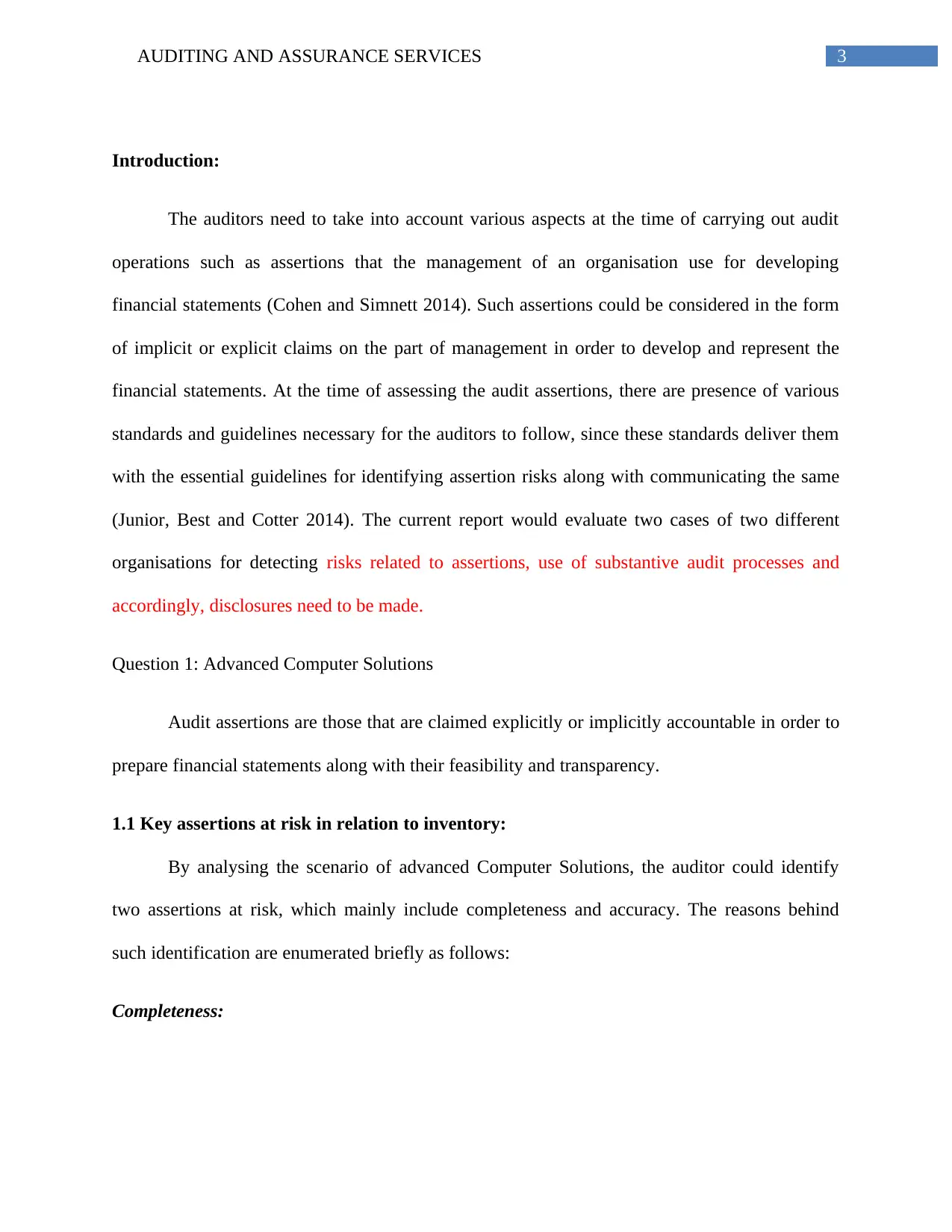
3AUDITING AND ASSURANCE SERVICES
Introduction:
The auditors need to take into account various aspects at the time of carrying out audit
operations such as assertions that the management of an organisation use for developing
financial statements (Cohen and Simnett 2014). Such assertions could be considered in the form
of implicit or explicit claims on the part of management in order to develop and represent the
financial statements. At the time of assessing the audit assertions, there are presence of various
standards and guidelines necessary for the auditors to follow, since these standards deliver them
with the essential guidelines for identifying assertion risks along with communicating the same
(Junior, Best and Cotter 2014). The current report would evaluate two cases of two different
organisations for detecting risks related to assertions, use of substantive audit processes and
accordingly, disclosures need to be made.
Question 1: Advanced Computer Solutions
Audit assertions are those that are claimed explicitly or implicitly accountable in order to
prepare financial statements along with their feasibility and transparency.
1.1 Key assertions at risk in relation to inventory:
By analysing the scenario of advanced Computer Solutions, the auditor could identify
two assertions at risk, which mainly include completeness and accuracy. The reasons behind
such identification are enumerated briefly as follows:
Completeness:
Introduction:
The auditors need to take into account various aspects at the time of carrying out audit
operations such as assertions that the management of an organisation use for developing
financial statements (Cohen and Simnett 2014). Such assertions could be considered in the form
of implicit or explicit claims on the part of management in order to develop and represent the
financial statements. At the time of assessing the audit assertions, there are presence of various
standards and guidelines necessary for the auditors to follow, since these standards deliver them
with the essential guidelines for identifying assertion risks along with communicating the same
(Junior, Best and Cotter 2014). The current report would evaluate two cases of two different
organisations for detecting risks related to assertions, use of substantive audit processes and
accordingly, disclosures need to be made.
Question 1: Advanced Computer Solutions
Audit assertions are those that are claimed explicitly or implicitly accountable in order to
prepare financial statements along with their feasibility and transparency.
1.1 Key assertions at risk in relation to inventory:
By analysing the scenario of advanced Computer Solutions, the auditor could identify
two assertions at risk, which mainly include completeness and accuracy. The reasons behind
such identification are enumerated briefly as follows:
Completeness:
Paraphrase This Document
Need a fresh take? Get an instant paraphrase of this document with our AI Paraphraser
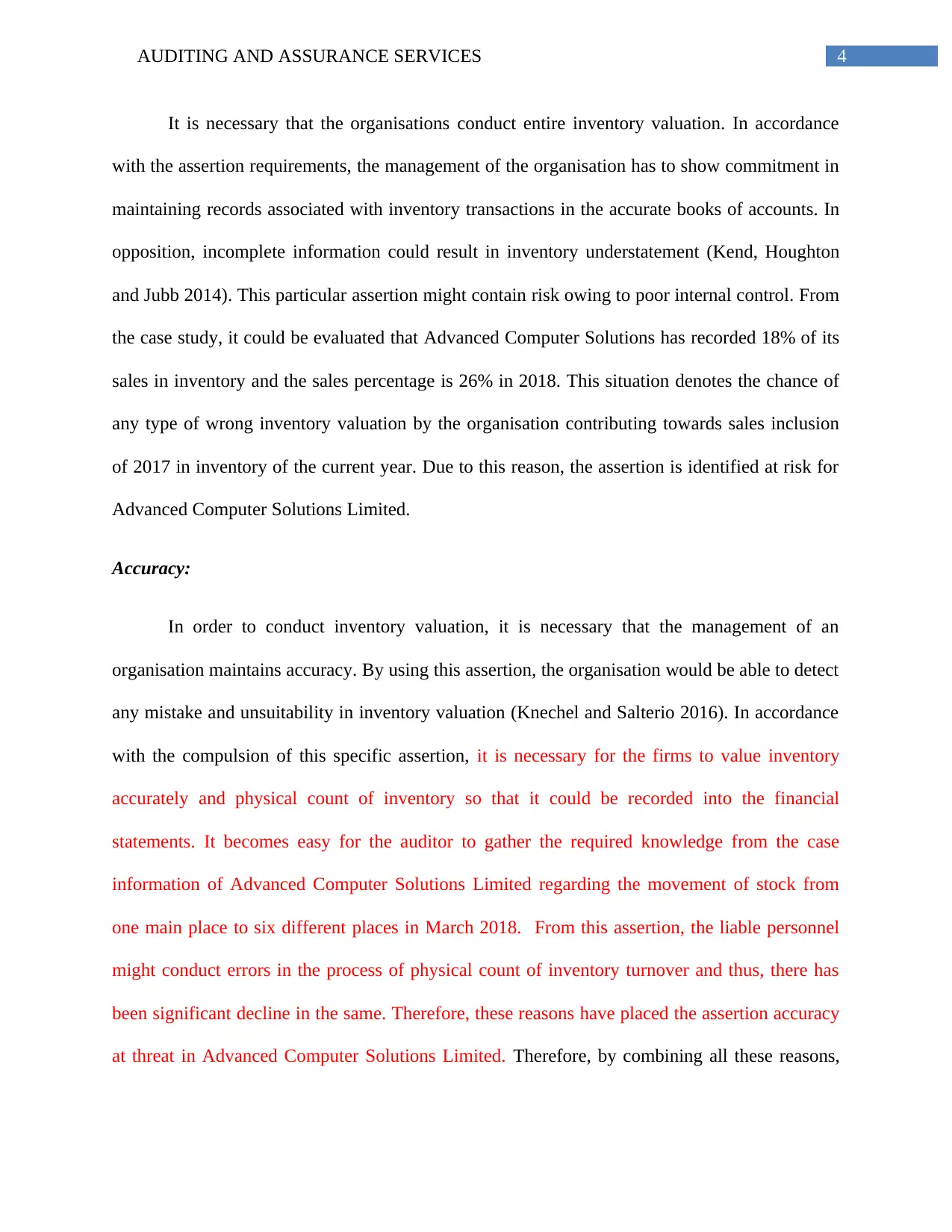
4AUDITING AND ASSURANCE SERVICES
It is necessary that the organisations conduct entire inventory valuation. In accordance
with the assertion requirements, the management of the organisation has to show commitment in
maintaining records associated with inventory transactions in the accurate books of accounts. In
opposition, incomplete information could result in inventory understatement (Kend, Houghton
and Jubb 2014). This particular assertion might contain risk owing to poor internal control. From
the case study, it could be evaluated that Advanced Computer Solutions has recorded 18% of its
sales in inventory and the sales percentage is 26% in 2018. This situation denotes the chance of
any type of wrong inventory valuation by the organisation contributing towards sales inclusion
of 2017 in inventory of the current year. Due to this reason, the assertion is identified at risk for
Advanced Computer Solutions Limited.
Accuracy:
In order to conduct inventory valuation, it is necessary that the management of an
organisation maintains accuracy. By using this assertion, the organisation would be able to detect
any mistake and unsuitability in inventory valuation (Knechel and Salterio 2016). In accordance
with the compulsion of this specific assertion, it is necessary for the firms to value inventory
accurately and physical count of inventory so that it could be recorded into the financial
statements. It becomes easy for the auditor to gather the required knowledge from the case
information of Advanced Computer Solutions Limited regarding the movement of stock from
one main place to six different places in March 2018. From this assertion, the liable personnel
might conduct errors in the process of physical count of inventory turnover and thus, there has
been significant decline in the same. Therefore, these reasons have placed the assertion accuracy
at threat in Advanced Computer Solutions Limited. Therefore, by combining all these reasons,
It is necessary that the organisations conduct entire inventory valuation. In accordance
with the assertion requirements, the management of the organisation has to show commitment in
maintaining records associated with inventory transactions in the accurate books of accounts. In
opposition, incomplete information could result in inventory understatement (Kend, Houghton
and Jubb 2014). This particular assertion might contain risk owing to poor internal control. From
the case study, it could be evaluated that Advanced Computer Solutions has recorded 18% of its
sales in inventory and the sales percentage is 26% in 2018. This situation denotes the chance of
any type of wrong inventory valuation by the organisation contributing towards sales inclusion
of 2017 in inventory of the current year. Due to this reason, the assertion is identified at risk for
Advanced Computer Solutions Limited.
Accuracy:
In order to conduct inventory valuation, it is necessary that the management of an
organisation maintains accuracy. By using this assertion, the organisation would be able to detect
any mistake and unsuitability in inventory valuation (Knechel and Salterio 2016). In accordance
with the compulsion of this specific assertion, it is necessary for the firms to value inventory
accurately and physical count of inventory so that it could be recorded into the financial
statements. It becomes easy for the auditor to gather the required knowledge from the case
information of Advanced Computer Solutions Limited regarding the movement of stock from
one main place to six different places in March 2018. From this assertion, the liable personnel
might conduct errors in the process of physical count of inventory turnover and thus, there has
been significant decline in the same. Therefore, these reasons have placed the assertion accuracy
at threat in Advanced Computer Solutions Limited. Therefore, by combining all these reasons,
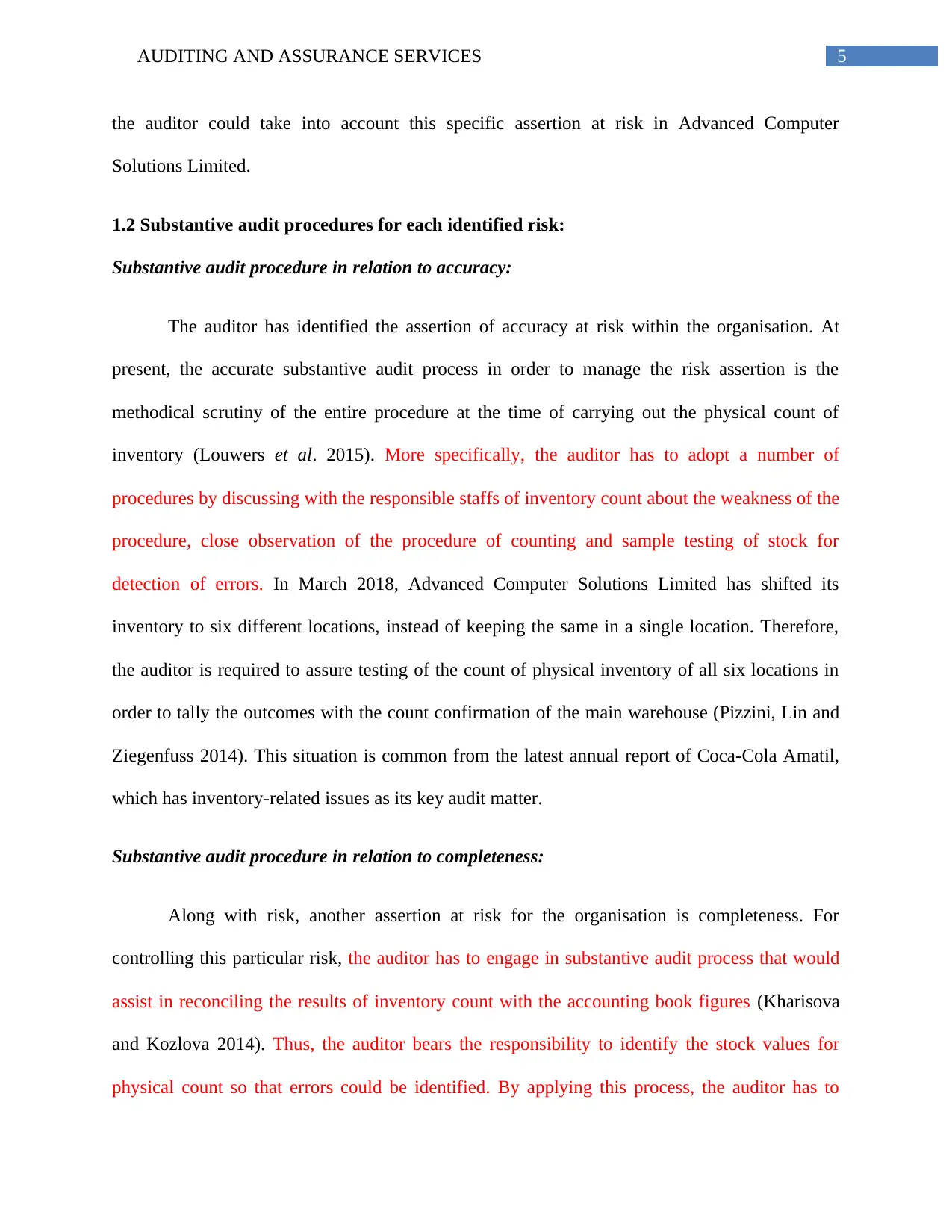
5AUDITING AND ASSURANCE SERVICES
the auditor could take into account this specific assertion at risk in Advanced Computer
Solutions Limited.
1.2 Substantive audit procedures for each identified risk:
Substantive audit procedure in relation to accuracy:
The auditor has identified the assertion of accuracy at risk within the organisation. At
present, the accurate substantive audit process in order to manage the risk assertion is the
methodical scrutiny of the entire procedure at the time of carrying out the physical count of
inventory (Louwers et al. 2015). More specifically, the auditor has to adopt a number of
procedures by discussing with the responsible staffs of inventory count about the weakness of the
procedure, close observation of the procedure of counting and sample testing of stock for
detection of errors. In March 2018, Advanced Computer Solutions Limited has shifted its
inventory to six different locations, instead of keeping the same in a single location. Therefore,
the auditor is required to assure testing of the count of physical inventory of all six locations in
order to tally the outcomes with the count confirmation of the main warehouse (Pizzini, Lin and
Ziegenfuss 2014). This situation is common from the latest annual report of Coca-Cola Amatil,
which has inventory-related issues as its key audit matter.
Substantive audit procedure in relation to completeness:
Along with risk, another assertion at risk for the organisation is completeness. For
controlling this particular risk, the auditor has to engage in substantive audit process that would
assist in reconciling the results of inventory count with the accounting book figures (Kharisova
and Kozlova 2014). Thus, the auditor bears the responsibility to identify the stock values for
physical count so that errors could be identified. By applying this process, the auditor has to
the auditor could take into account this specific assertion at risk in Advanced Computer
Solutions Limited.
1.2 Substantive audit procedures for each identified risk:
Substantive audit procedure in relation to accuracy:
The auditor has identified the assertion of accuracy at risk within the organisation. At
present, the accurate substantive audit process in order to manage the risk assertion is the
methodical scrutiny of the entire procedure at the time of carrying out the physical count of
inventory (Louwers et al. 2015). More specifically, the auditor has to adopt a number of
procedures by discussing with the responsible staffs of inventory count about the weakness of the
procedure, close observation of the procedure of counting and sample testing of stock for
detection of errors. In March 2018, Advanced Computer Solutions Limited has shifted its
inventory to six different locations, instead of keeping the same in a single location. Therefore,
the auditor is required to assure testing of the count of physical inventory of all six locations in
order to tally the outcomes with the count confirmation of the main warehouse (Pizzini, Lin and
Ziegenfuss 2014). This situation is common from the latest annual report of Coca-Cola Amatil,
which has inventory-related issues as its key audit matter.
Substantive audit procedure in relation to completeness:
Along with risk, another assertion at risk for the organisation is completeness. For
controlling this particular risk, the auditor has to engage in substantive audit process that would
assist in reconciling the results of inventory count with the accounting book figures (Kharisova
and Kozlova 2014). Thus, the auditor bears the responsibility to identify the stock values for
physical count so that errors could be identified. By applying this process, the auditor has to
⊘ This is a preview!⊘
Do you want full access?
Subscribe today to unlock all pages.

Trusted by 1+ million students worldwide
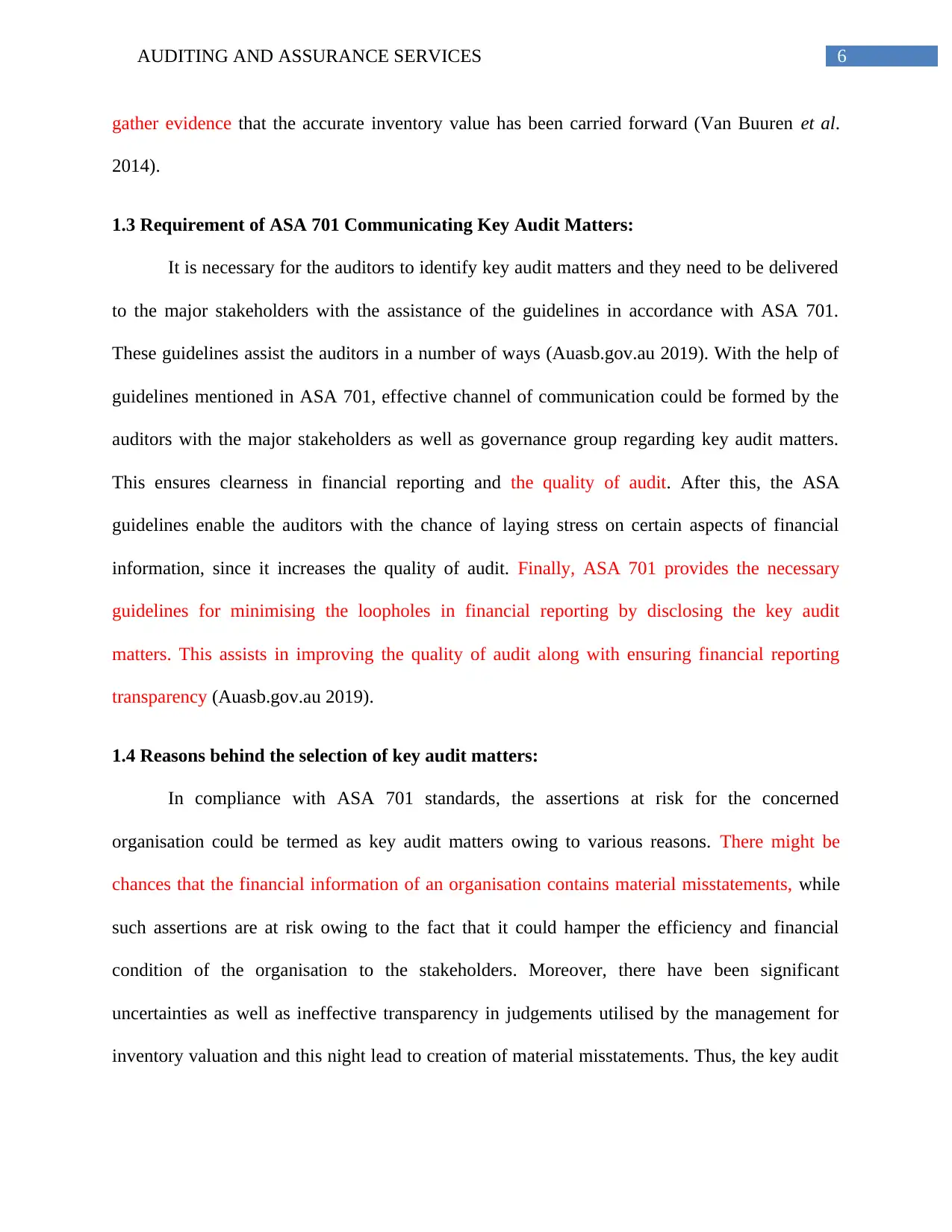
6AUDITING AND ASSURANCE SERVICES
gather evidence that the accurate inventory value has been carried forward (Van Buuren et al.
2014).
1.3 Requirement of ASA 701 Communicating Key Audit Matters:
It is necessary for the auditors to identify key audit matters and they need to be delivered
to the major stakeholders with the assistance of the guidelines in accordance with ASA 701.
These guidelines assist the auditors in a number of ways (Auasb.gov.au 2019). With the help of
guidelines mentioned in ASA 701, effective channel of communication could be formed by the
auditors with the major stakeholders as well as governance group regarding key audit matters.
This ensures clearness in financial reporting and the quality of audit. After this, the ASA
guidelines enable the auditors with the chance of laying stress on certain aspects of financial
information, since it increases the quality of audit. Finally, ASA 701 provides the necessary
guidelines for minimising the loopholes in financial reporting by disclosing the key audit
matters. This assists in improving the quality of audit along with ensuring financial reporting
transparency (Auasb.gov.au 2019).
1.4 Reasons behind the selection of key audit matters:
In compliance with ASA 701 standards, the assertions at risk for the concerned
organisation could be termed as key audit matters owing to various reasons. There might be
chances that the financial information of an organisation contains material misstatements, while
such assertions are at risk owing to the fact that it could hamper the efficiency and financial
condition of the organisation to the stakeholders. Moreover, there have been significant
uncertainties as well as ineffective transparency in judgements utilised by the management for
inventory valuation and this night lead to creation of material misstatements. Thus, the key audit
gather evidence that the accurate inventory value has been carried forward (Van Buuren et al.
2014).
1.3 Requirement of ASA 701 Communicating Key Audit Matters:
It is necessary for the auditors to identify key audit matters and they need to be delivered
to the major stakeholders with the assistance of the guidelines in accordance with ASA 701.
These guidelines assist the auditors in a number of ways (Auasb.gov.au 2019). With the help of
guidelines mentioned in ASA 701, effective channel of communication could be formed by the
auditors with the major stakeholders as well as governance group regarding key audit matters.
This ensures clearness in financial reporting and the quality of audit. After this, the ASA
guidelines enable the auditors with the chance of laying stress on certain aspects of financial
information, since it increases the quality of audit. Finally, ASA 701 provides the necessary
guidelines for minimising the loopholes in financial reporting by disclosing the key audit
matters. This assists in improving the quality of audit along with ensuring financial reporting
transparency (Auasb.gov.au 2019).
1.4 Reasons behind the selection of key audit matters:
In compliance with ASA 701 standards, the assertions at risk for the concerned
organisation could be termed as key audit matters owing to various reasons. There might be
chances that the financial information of an organisation contains material misstatements, while
such assertions are at risk owing to the fact that it could hamper the efficiency and financial
condition of the organisation to the stakeholders. Moreover, there have been significant
uncertainties as well as ineffective transparency in judgements utilised by the management for
inventory valuation and this night lead to creation of material misstatements. Thus, the key audit
Paraphrase This Document
Need a fresh take? Get an instant paraphrase of this document with our AI Paraphraser
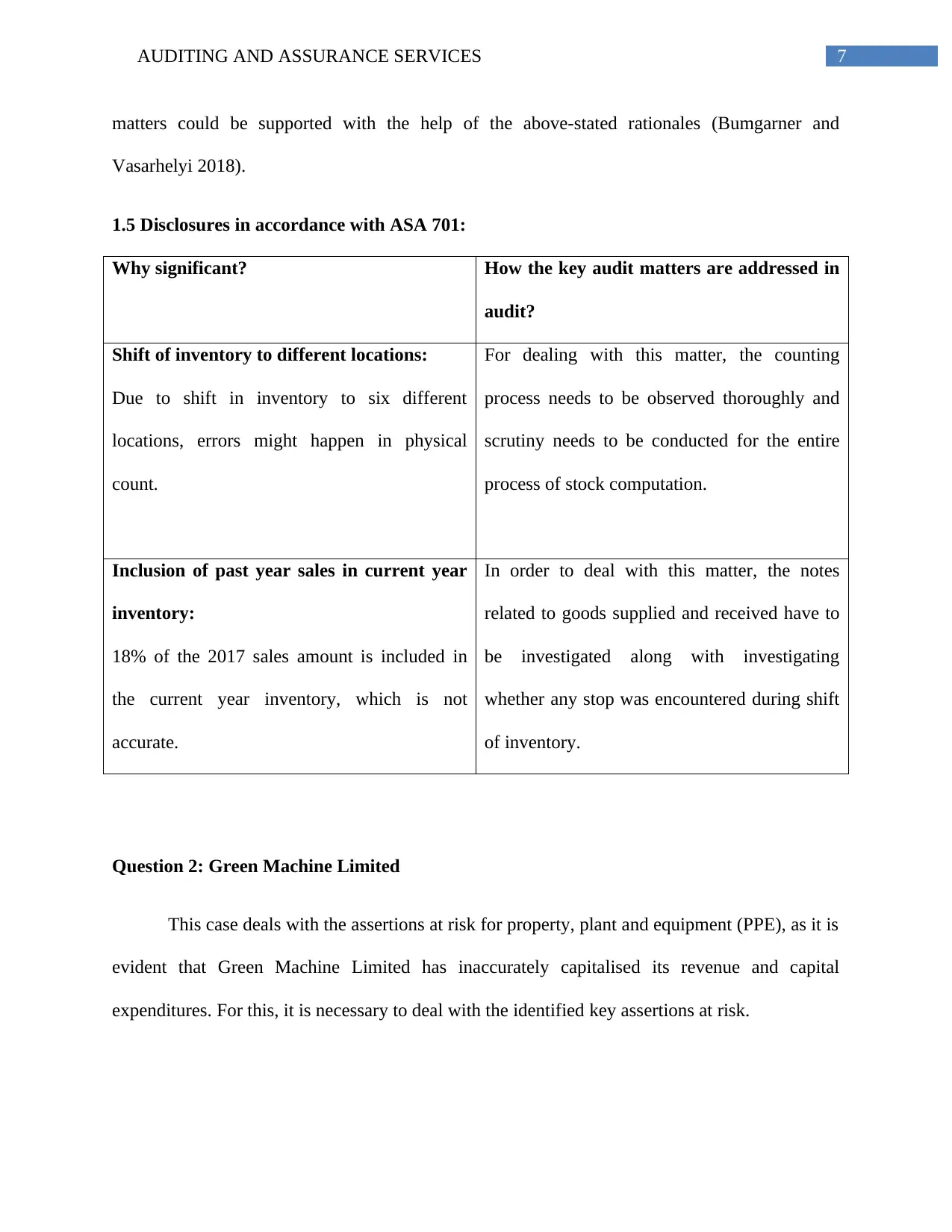
7AUDITING AND ASSURANCE SERVICES
matters could be supported with the help of the above-stated rationales (Bumgarner and
Vasarhelyi 2018).
1.5 Disclosures in accordance with ASA 701:
Why significant? How the key audit matters are addressed in
audit?
Shift of inventory to different locations:
Due to shift in inventory to six different
locations, errors might happen in physical
count.
For dealing with this matter, the counting
process needs to be observed thoroughly and
scrutiny needs to be conducted for the entire
process of stock computation.
Inclusion of past year sales in current year
inventory:
18% of the 2017 sales amount is included in
the current year inventory, which is not
accurate.
In order to deal with this matter, the notes
related to goods supplied and received have to
be investigated along with investigating
whether any stop was encountered during shift
of inventory.
Question 2: Green Machine Limited
This case deals with the assertions at risk for property, plant and equipment (PPE), as it is
evident that Green Machine Limited has inaccurately capitalised its revenue and capital
expenditures. For this, it is necessary to deal with the identified key assertions at risk.
matters could be supported with the help of the above-stated rationales (Bumgarner and
Vasarhelyi 2018).
1.5 Disclosures in accordance with ASA 701:
Why significant? How the key audit matters are addressed in
audit?
Shift of inventory to different locations:
Due to shift in inventory to six different
locations, errors might happen in physical
count.
For dealing with this matter, the counting
process needs to be observed thoroughly and
scrutiny needs to be conducted for the entire
process of stock computation.
Inclusion of past year sales in current year
inventory:
18% of the 2017 sales amount is included in
the current year inventory, which is not
accurate.
In order to deal with this matter, the notes
related to goods supplied and received have to
be investigated along with investigating
whether any stop was encountered during shift
of inventory.
Question 2: Green Machine Limited
This case deals with the assertions at risk for property, plant and equipment (PPE), as it is
evident that Green Machine Limited has inaccurately capitalised its revenue and capital
expenditures. For this, it is necessary to deal with the identified key assertions at risk.
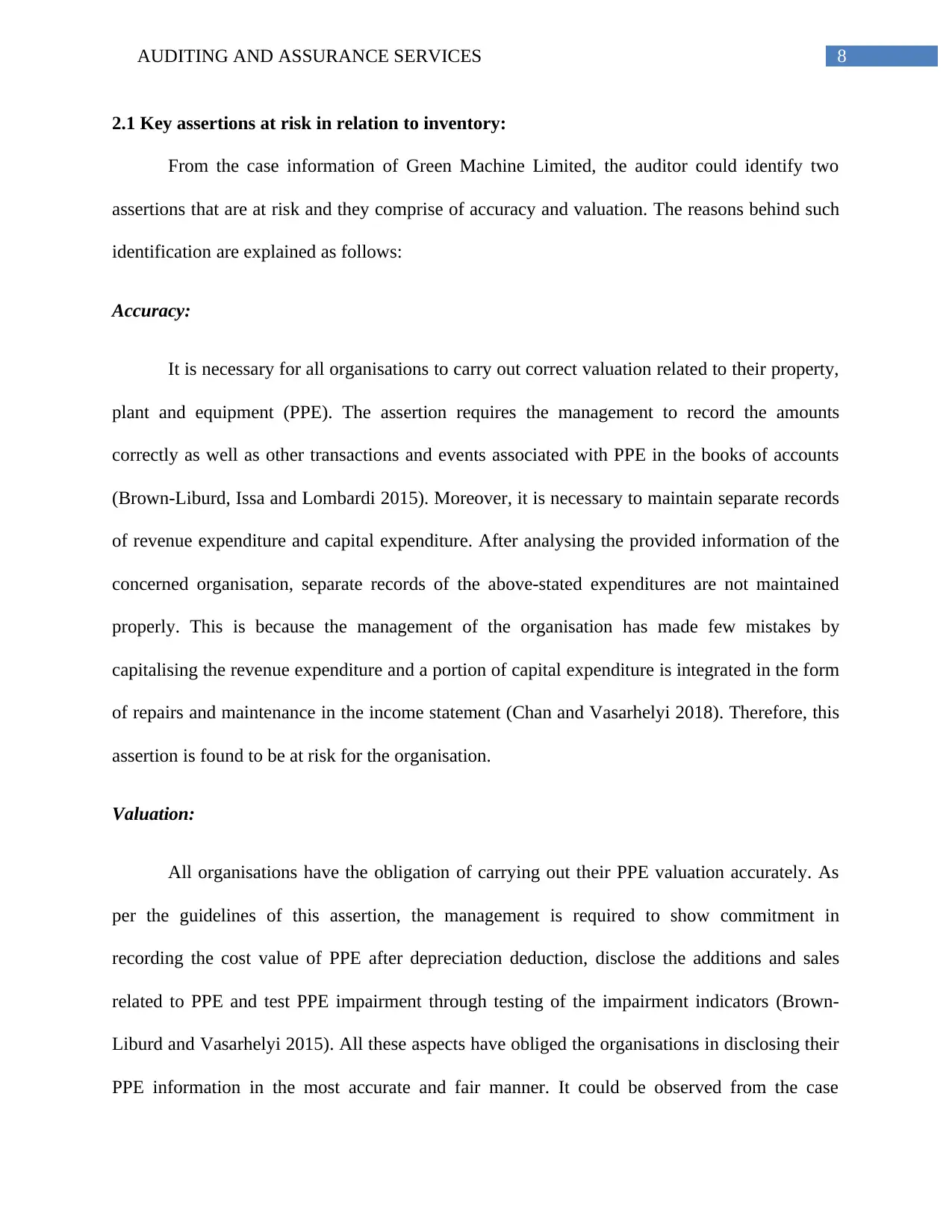
8AUDITING AND ASSURANCE SERVICES
2.1 Key assertions at risk in relation to inventory:
From the case information of Green Machine Limited, the auditor could identify two
assertions that are at risk and they comprise of accuracy and valuation. The reasons behind such
identification are explained as follows:
Accuracy:
It is necessary for all organisations to carry out correct valuation related to their property,
plant and equipment (PPE). The assertion requires the management to record the amounts
correctly as well as other transactions and events associated with PPE in the books of accounts
(Brown-Liburd, Issa and Lombardi 2015). Moreover, it is necessary to maintain separate records
of revenue expenditure and capital expenditure. After analysing the provided information of the
concerned organisation, separate records of the above-stated expenditures are not maintained
properly. This is because the management of the organisation has made few mistakes by
capitalising the revenue expenditure and a portion of capital expenditure is integrated in the form
of repairs and maintenance in the income statement (Chan and Vasarhelyi 2018). Therefore, this
assertion is found to be at risk for the organisation.
Valuation:
All organisations have the obligation of carrying out their PPE valuation accurately. As
per the guidelines of this assertion, the management is required to show commitment in
recording the cost value of PPE after depreciation deduction, disclose the additions and sales
related to PPE and test PPE impairment through testing of the impairment indicators (Brown-
Liburd and Vasarhelyi 2015). All these aspects have obliged the organisations in disclosing their
PPE information in the most accurate and fair manner. It could be observed from the case
2.1 Key assertions at risk in relation to inventory:
From the case information of Green Machine Limited, the auditor could identify two
assertions that are at risk and they comprise of accuracy and valuation. The reasons behind such
identification are explained as follows:
Accuracy:
It is necessary for all organisations to carry out correct valuation related to their property,
plant and equipment (PPE). The assertion requires the management to record the amounts
correctly as well as other transactions and events associated with PPE in the books of accounts
(Brown-Liburd, Issa and Lombardi 2015). Moreover, it is necessary to maintain separate records
of revenue expenditure and capital expenditure. After analysing the provided information of the
concerned organisation, separate records of the above-stated expenditures are not maintained
properly. This is because the management of the organisation has made few mistakes by
capitalising the revenue expenditure and a portion of capital expenditure is integrated in the form
of repairs and maintenance in the income statement (Chan and Vasarhelyi 2018). Therefore, this
assertion is found to be at risk for the organisation.
Valuation:
All organisations have the obligation of carrying out their PPE valuation accurately. As
per the guidelines of this assertion, the management is required to show commitment in
recording the cost value of PPE after depreciation deduction, disclose the additions and sales
related to PPE and test PPE impairment through testing of the impairment indicators (Brown-
Liburd and Vasarhelyi 2015). All these aspects have obliged the organisations in disclosing their
PPE information in the most accurate and fair manner. It could be observed from the case
⊘ This is a preview!⊘
Do you want full access?
Subscribe today to unlock all pages.

Trusted by 1+ million students worldwide
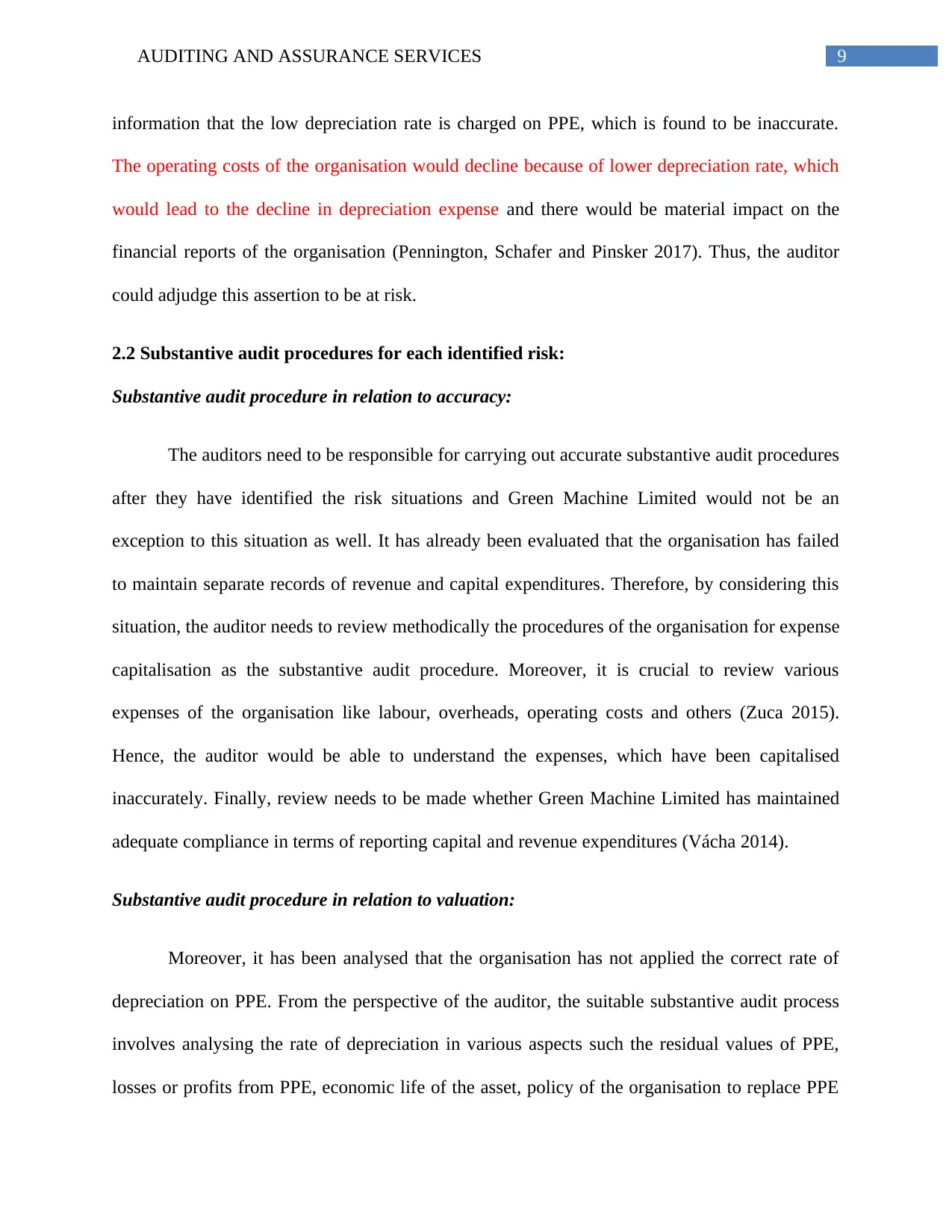
9AUDITING AND ASSURANCE SERVICES
information that the low depreciation rate is charged on PPE, which is found to be inaccurate.
The operating costs of the organisation would decline because of lower depreciation rate, which
would lead to the decline in depreciation expense and there would be material impact on the
financial reports of the organisation (Pennington, Schafer and Pinsker 2017). Thus, the auditor
could adjudge this assertion to be at risk.
2.2 Substantive audit procedures for each identified risk:
Substantive audit procedure in relation to accuracy:
The auditors need to be responsible for carrying out accurate substantive audit procedures
after they have identified the risk situations and Green Machine Limited would not be an
exception to this situation as well. It has already been evaluated that the organisation has failed
to maintain separate records of revenue and capital expenditures. Therefore, by considering this
situation, the auditor needs to review methodically the procedures of the organisation for expense
capitalisation as the substantive audit procedure. Moreover, it is crucial to review various
expenses of the organisation like labour, overheads, operating costs and others (Zuca 2015).
Hence, the auditor would be able to understand the expenses, which have been capitalised
inaccurately. Finally, review needs to be made whether Green Machine Limited has maintained
adequate compliance in terms of reporting capital and revenue expenditures (Vácha 2014).
Substantive audit procedure in relation to valuation:
Moreover, it has been analysed that the organisation has not applied the correct rate of
depreciation on PPE. From the perspective of the auditor, the suitable substantive audit process
involves analysing the rate of depreciation in various aspects such the residual values of PPE,
losses or profits from PPE, economic life of the asset, policy of the organisation to replace PPE
information that the low depreciation rate is charged on PPE, which is found to be inaccurate.
The operating costs of the organisation would decline because of lower depreciation rate, which
would lead to the decline in depreciation expense and there would be material impact on the
financial reports of the organisation (Pennington, Schafer and Pinsker 2017). Thus, the auditor
could adjudge this assertion to be at risk.
2.2 Substantive audit procedures for each identified risk:
Substantive audit procedure in relation to accuracy:
The auditors need to be responsible for carrying out accurate substantive audit procedures
after they have identified the risk situations and Green Machine Limited would not be an
exception to this situation as well. It has already been evaluated that the organisation has failed
to maintain separate records of revenue and capital expenditures. Therefore, by considering this
situation, the auditor needs to review methodically the procedures of the organisation for expense
capitalisation as the substantive audit procedure. Moreover, it is crucial to review various
expenses of the organisation like labour, overheads, operating costs and others (Zuca 2015).
Hence, the auditor would be able to understand the expenses, which have been capitalised
inaccurately. Finally, review needs to be made whether Green Machine Limited has maintained
adequate compliance in terms of reporting capital and revenue expenditures (Vácha 2014).
Substantive audit procedure in relation to valuation:
Moreover, it has been analysed that the organisation has not applied the correct rate of
depreciation on PPE. From the perspective of the auditor, the suitable substantive audit process
involves analysing the rate of depreciation in various aspects such the residual values of PPE,
losses or profits from PPE, economic life of the asset, policy of the organisation to replace PPE
Paraphrase This Document
Need a fresh take? Get an instant paraphrase of this document with our AI Paraphraser
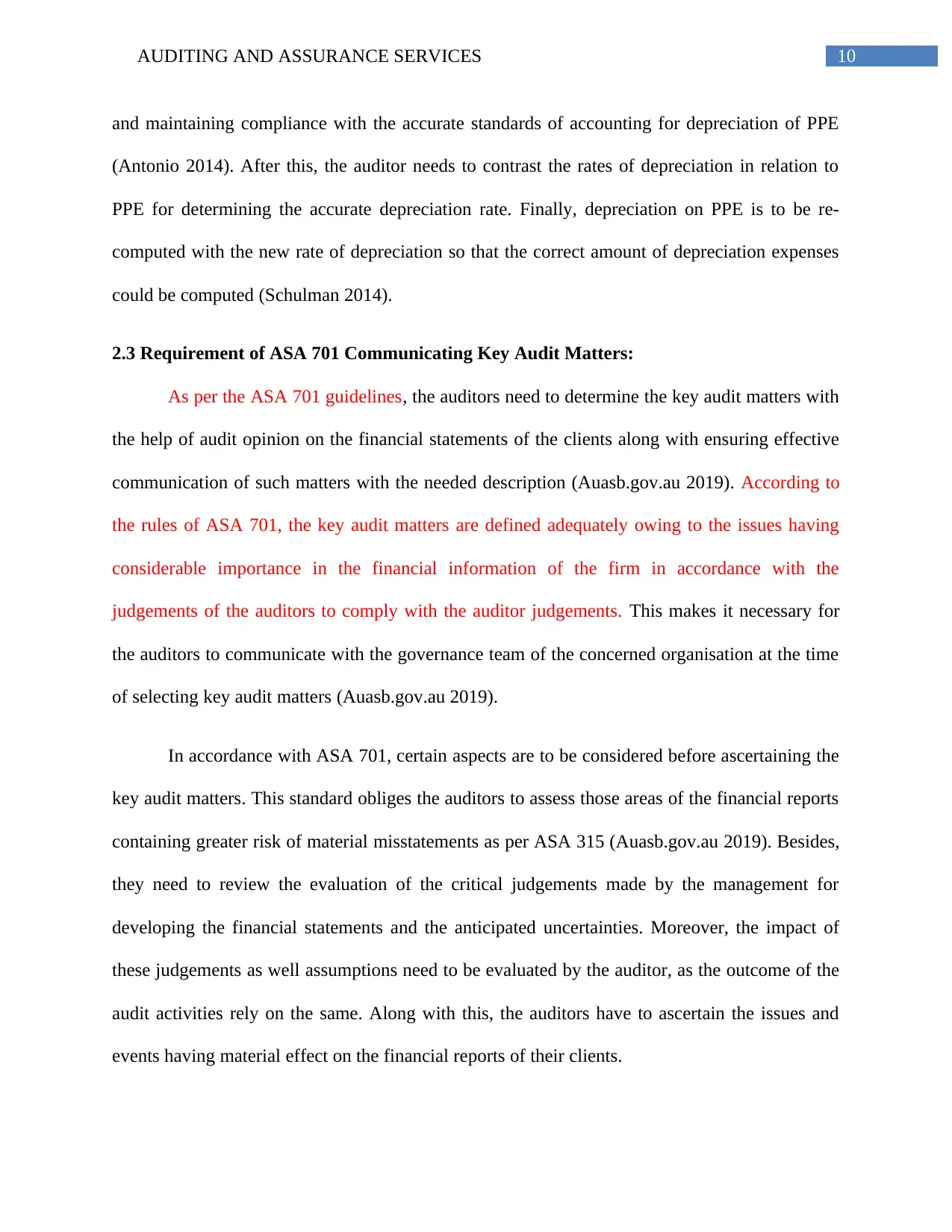
10AUDITING AND ASSURANCE SERVICES
and maintaining compliance with the accurate standards of accounting for depreciation of PPE
(Antonio 2014). After this, the auditor needs to contrast the rates of depreciation in relation to
PPE for determining the accurate depreciation rate. Finally, depreciation on PPE is to be re-
computed with the new rate of depreciation so that the correct amount of depreciation expenses
could be computed (Schulman 2014).
2.3 Requirement of ASA 701 Communicating Key Audit Matters:
As per the ASA 701 guidelines, the auditors need to determine the key audit matters with
the help of audit opinion on the financial statements of the clients along with ensuring effective
communication of such matters with the needed description (Auasb.gov.au 2019). According to
the rules of ASA 701, the key audit matters are defined adequately owing to the issues having
considerable importance in the financial information of the firm in accordance with the
judgements of the auditors to comply with the auditor judgements. This makes it necessary for
the auditors to communicate with the governance team of the concerned organisation at the time
of selecting key audit matters (Auasb.gov.au 2019).
In accordance with ASA 701, certain aspects are to be considered before ascertaining the
key audit matters. This standard obliges the auditors to assess those areas of the financial reports
containing greater risk of material misstatements as per ASA 315 (Auasb.gov.au 2019). Besides,
they need to review the evaluation of the critical judgements made by the management for
developing the financial statements and the anticipated uncertainties. Moreover, the impact of
these judgements as well assumptions need to be evaluated by the auditor, as the outcome of the
audit activities rely on the same. Along with this, the auditors have to ascertain the issues and
events having material effect on the financial reports of their clients.
and maintaining compliance with the accurate standards of accounting for depreciation of PPE
(Antonio 2014). After this, the auditor needs to contrast the rates of depreciation in relation to
PPE for determining the accurate depreciation rate. Finally, depreciation on PPE is to be re-
computed with the new rate of depreciation so that the correct amount of depreciation expenses
could be computed (Schulman 2014).
2.3 Requirement of ASA 701 Communicating Key Audit Matters:
As per the ASA 701 guidelines, the auditors need to determine the key audit matters with
the help of audit opinion on the financial statements of the clients along with ensuring effective
communication of such matters with the needed description (Auasb.gov.au 2019). According to
the rules of ASA 701, the key audit matters are defined adequately owing to the issues having
considerable importance in the financial information of the firm in accordance with the
judgements of the auditors to comply with the auditor judgements. This makes it necessary for
the auditors to communicate with the governance team of the concerned organisation at the time
of selecting key audit matters (Auasb.gov.au 2019).
In accordance with ASA 701, certain aspects are to be considered before ascertaining the
key audit matters. This standard obliges the auditors to assess those areas of the financial reports
containing greater risk of material misstatements as per ASA 315 (Auasb.gov.au 2019). Besides,
they need to review the evaluation of the critical judgements made by the management for
developing the financial statements and the anticipated uncertainties. Moreover, the impact of
these judgements as well assumptions need to be evaluated by the auditor, as the outcome of the
audit activities rely on the same. Along with this, the auditors have to ascertain the issues and
events having material effect on the financial reports of their clients.
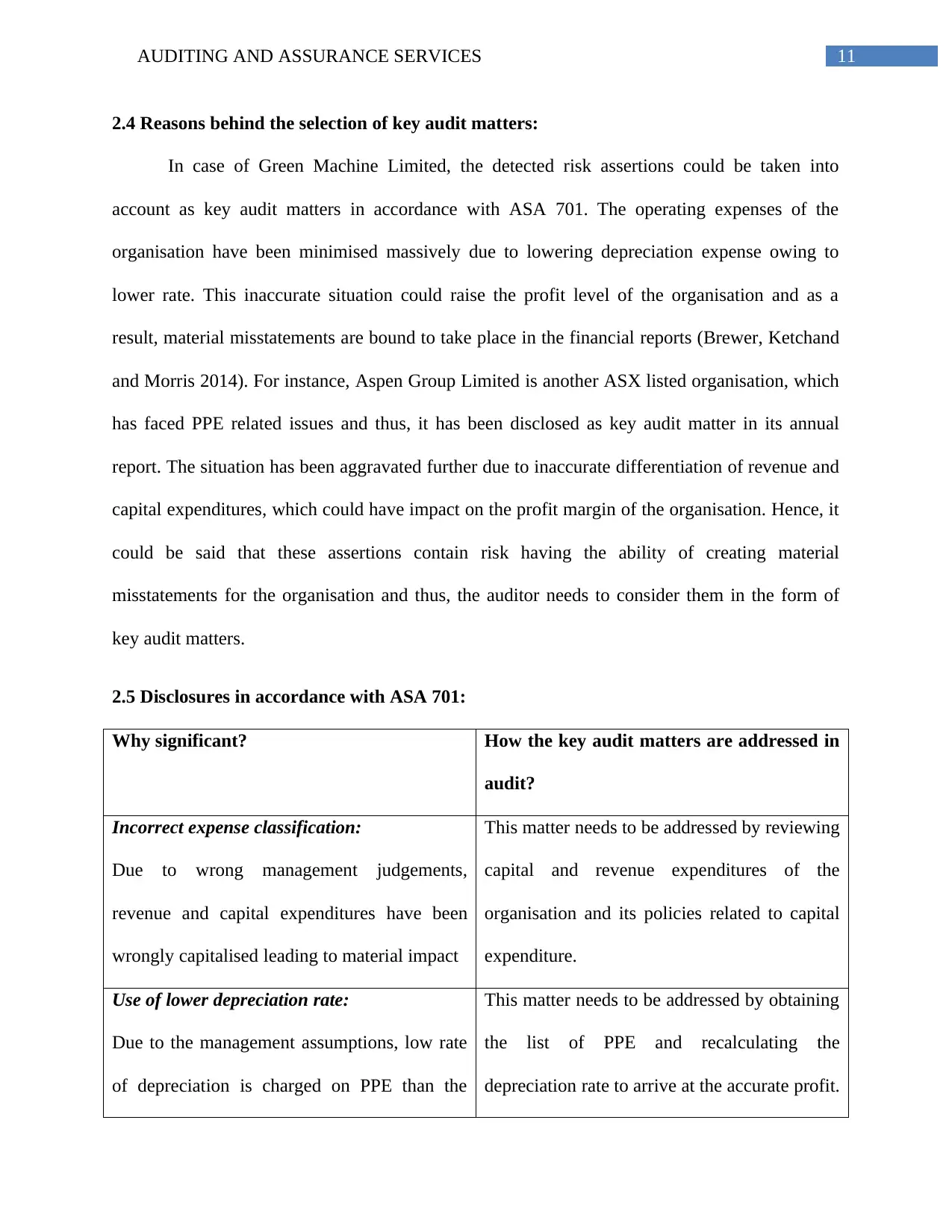
11AUDITING AND ASSURANCE SERVICES
2.4 Reasons behind the selection of key audit matters:
In case of Green Machine Limited, the detected risk assertions could be taken into
account as key audit matters in accordance with ASA 701. The operating expenses of the
organisation have been minimised massively due to lowering depreciation expense owing to
lower rate. This inaccurate situation could raise the profit level of the organisation and as a
result, material misstatements are bound to take place in the financial reports (Brewer, Ketchand
and Morris 2014). For instance, Aspen Group Limited is another ASX listed organisation, which
has faced PPE related issues and thus, it has been disclosed as key audit matter in its annual
report. The situation has been aggravated further due to inaccurate differentiation of revenue and
capital expenditures, which could have impact on the profit margin of the organisation. Hence, it
could be said that these assertions contain risk having the ability of creating material
misstatements for the organisation and thus, the auditor needs to consider them in the form of
key audit matters.
2.5 Disclosures in accordance with ASA 701:
Why significant? How the key audit matters are addressed in
audit?
Incorrect expense classification:
Due to wrong management judgements,
revenue and capital expenditures have been
wrongly capitalised leading to material impact
This matter needs to be addressed by reviewing
capital and revenue expenditures of the
organisation and its policies related to capital
expenditure.
Use of lower depreciation rate:
Due to the management assumptions, low rate
of depreciation is charged on PPE than the
This matter needs to be addressed by obtaining
the list of PPE and recalculating the
depreciation rate to arrive at the accurate profit.
2.4 Reasons behind the selection of key audit matters:
In case of Green Machine Limited, the detected risk assertions could be taken into
account as key audit matters in accordance with ASA 701. The operating expenses of the
organisation have been minimised massively due to lowering depreciation expense owing to
lower rate. This inaccurate situation could raise the profit level of the organisation and as a
result, material misstatements are bound to take place in the financial reports (Brewer, Ketchand
and Morris 2014). For instance, Aspen Group Limited is another ASX listed organisation, which
has faced PPE related issues and thus, it has been disclosed as key audit matter in its annual
report. The situation has been aggravated further due to inaccurate differentiation of revenue and
capital expenditures, which could have impact on the profit margin of the organisation. Hence, it
could be said that these assertions contain risk having the ability of creating material
misstatements for the organisation and thus, the auditor needs to consider them in the form of
key audit matters.
2.5 Disclosures in accordance with ASA 701:
Why significant? How the key audit matters are addressed in
audit?
Incorrect expense classification:
Due to wrong management judgements,
revenue and capital expenditures have been
wrongly capitalised leading to material impact
This matter needs to be addressed by reviewing
capital and revenue expenditures of the
organisation and its policies related to capital
expenditure.
Use of lower depreciation rate:
Due to the management assumptions, low rate
of depreciation is charged on PPE than the
This matter needs to be addressed by obtaining
the list of PPE and recalculating the
depreciation rate to arrive at the accurate profit.
⊘ This is a preview!⊘
Do you want full access?
Subscribe today to unlock all pages.

Trusted by 1+ million students worldwide
1 out of 16
Related Documents
Your All-in-One AI-Powered Toolkit for Academic Success.
+13062052269
info@desklib.com
Available 24*7 on WhatsApp / Email
![[object Object]](/_next/static/media/star-bottom.7253800d.svg)
Unlock your academic potential
Copyright © 2020–2025 A2Z Services. All Rights Reserved. Developed and managed by ZUCOL.





